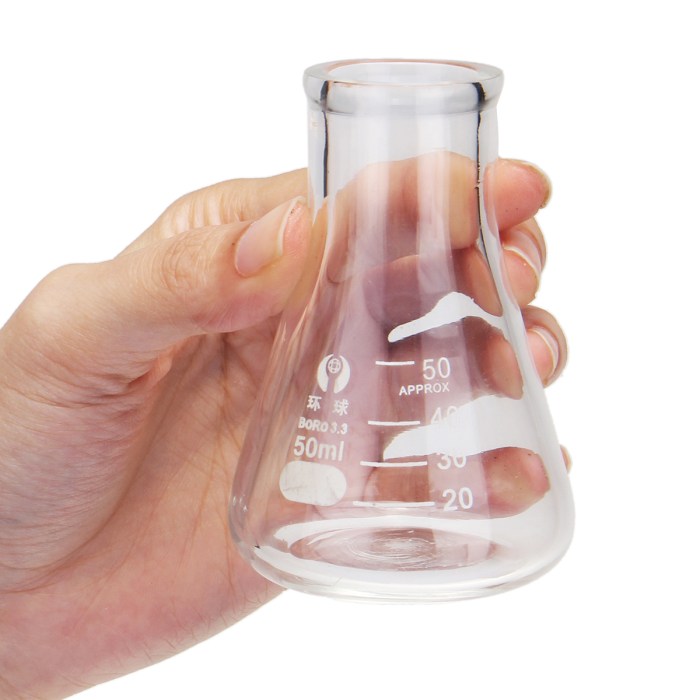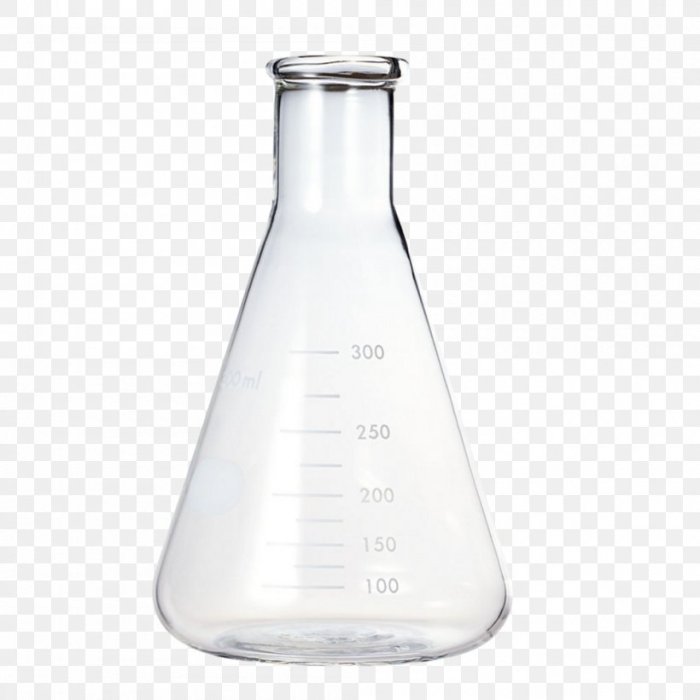Which of the glassware shown below is an erlenmeyer flask – In the realm of laboratory glassware, the Erlenmeyer flask stands out as a versatile and indispensable tool. With its distinctive conical shape and narrow neck, this flask has become a mainstay in scientific research and experimentation. This comprehensive guide will delve into the intricacies of the Erlenmeyer flask, exploring its unique characteristics, applications, and advantages over other glassware.
The Erlenmeyer flask, with its characteristic conical shape and narrow neck, stands apart from other glassware. Its unique design lends itself to a wide range of laboratory procedures, including mixing, heating, and titration.
Identification of Erlenmeyer Flask

An Erlenmeyer flask is a type of laboratory glassware characterized by its conical shape and narrow neck. The conical shape provides stability, while the narrow neck facilitates the swirling of liquids and the addition of reagents without spilling.
Erlenmeyer flasks are commonly used in chemistry, biology, and other scientific disciplines for various purposes, including:
- Titrations
- Mixing and stirring solutions
- Heating liquids
- Storing chemicals
Comparison with Other Glassware
| Glassware | Shape | Size | Common Uses |
|---|---|---|---|
| Erlenmeyer Flask | Conical with narrow neck | 50 mL to 2000 mL | Titrations, mixing, heating |
| Beaker | Cylindrical with wide mouth | 50 mL to 5000 mL | Mixing, storing, heating |
| Round-Bottom Flask | Round with narrow neck | 50 mL to 5000 mL | Distillation, reflux, heating |
| Graduated Cylinder | Cylindrical with narrow spout | 10 mL to 1000 mL | Measuring volumes |
The Erlenmeyer flask distinguishes itself from other glassware due to its conical shape, which provides stability and facilitates swirling, and its narrow neck, which enables precise liquid addition.
Advantages and Disadvantages

Advantages:
- Stability: The conical shape provides a wide base for stability, making it less likely to tip over.
- Swirling: The narrow neck allows for easy swirling of liquids, facilitating mixing and gas exchange.
- Precise Liquid Addition: The narrow neck enables the precise addition of reagents without spilling.
Disadvantages:
- Narrow Opening: The narrow neck can make it difficult to clean the flask thoroughly or add large solids.
- Not Suitable for Accurate Volume Measurement: The conical shape makes it difficult to measure volumes accurately.
- Limited Temperature Range: Erlenmeyer flasks are not suitable for use at extreme temperatures.
In cases where the narrow opening or limited temperature range of an Erlenmeyer flask poses a problem, alternative glassware such as beakers or round-bottom flasks may be more appropriate.
Applications in Different Fields: Which Of The Glassware Shown Below Is An Erlenmeyer Flask

Chemistry:
- Titrations: Erlenmeyer flasks are commonly used in titrations to hold the analyte solution.
- Mixing and Stirring: The conical shape and narrow neck facilitate the mixing and stirring of solutions.
- Heating Liquids: Erlenmeyer flasks can be used to heat liquids over a Bunsen burner or hot plate.
Biology:, Which of the glassware shown below is an erlenmeyer flask
- Culturing Microorganisms: Erlenmeyer flasks are used to culture microorganisms in liquid media.
- Preparing Solutions: The narrow neck allows for the precise addition of reagents when preparing solutions.
- Measuring Cell Density: The conical shape makes it easier to measure cell density using a spectrophotometer.
Other Scientific Disciplines:
- Environmental Science: Erlenmeyer flasks are used to collect and analyze water samples.
- Food Science: The narrow neck facilitates the addition of ingredients when preparing food samples.
- Pharmacology: Erlenmeyer flasks are used to mix and store pharmaceutical solutions.
Helpful Answers
What is the primary use of an Erlenmeyer flask?
Erlenmeyer flasks are primarily used for mixing, heating, and titration of liquids in laboratory settings.
What is the distinguishing feature of an Erlenmeyer flask?
The conical shape with a narrow neck is the defining characteristic of an Erlenmeyer flask.
Can an Erlenmeyer flask be used for accurate volume measurements?
No, Erlenmeyer flasks are not calibrated for precise volume measurements and should not be used for this purpose.